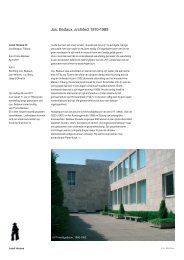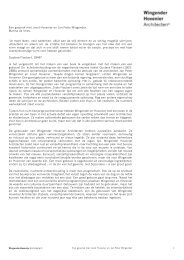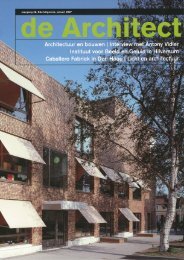Berlin 2009 - Wingender Hovenier Architecten
Berlin 2009 - Wingender Hovenier Architecten
Berlin 2009 - Wingender Hovenier Architecten
Sie wollen auch ein ePaper? Erhöhen Sie die Reichweite Ihrer Titel.
YUMPU macht aus Druck-PDFs automatisch weboptimierte ePaper, die Google liebt.
Neues Museum, <strong>Berlin</strong>, 1997-<strong>2009</strong><br />
David Chipperfield<br />
In 1997 David Chipperfield Architects<br />
won an international competition for<br />
the restoration of Friedrich August<br />
Stüler’s Neues Museum, originally<br />
built between 1841 and 1859. Located<br />
on Museum Island in the heart of the<br />
former East <strong>Berlin</strong>, the building was<br />
initially constructed to extend the space<br />
of the Altes Museum, built immediately<br />
to the south by Stüler’s teacher Karl<br />
Friedrich Schinkel. The original design<br />
had formed part of an overall<br />
architectural concept for Museum<br />
Island - prompted by Friedrich<br />
Wilhelm IV - of a series of art and<br />
archaeological museums styled so as<br />
to promote a greater appreciation of<br />
classical antiquity. Among these<br />
museums, and in terms of its<br />
construction and rich interior<br />
decoration, the Neues Museum was<br />
considered the most important<br />
monumental Prussian building of its<br />
era. Seen today alongside the four other<br />
reconstructed museum buildings on<br />
the island, Stüler’s Neues Museum was<br />
the only structure that remained ruined<br />
from the war for almost five decades - a<br />
contrast that demonstrated ideas of<br />
history and decay in a compelling<br />
and powerful way, although throughout<br />
the building the degree of destruction<br />
varied greatly. Certain interiors survived<br />
almost completely, with elaborate<br />
finishes and ceiling frescos still intact,<br />
while other building elements existed<br />
only as the enclosures of a gaping void.<br />
The power of the ruin not least<br />
stemmed from this exposed brickwork<br />
shell, investing the building, 150 years<br />
after it was first imagined, with the<br />
indelible presence of a picturesque<br />
classical ruin. Given this evocative yet<br />
inaccessible space, the restoration of<br />
the Neues Museum follows a principle<br />
of conservation rather than<br />
reconstruction - the design gives back<br />
only enough context so that the<br />
significance of the whole structure<br />
and the sequence of spaces contained<br />
within it are legible. Accordingly, the<br />
missing north west wing and south east<br />
bay are rebuilt, the enfilade of rooms<br />
is restored, and the stair and courtyard<br />
spaces are designed so as to maintain<br />
elements of the building’s own decay.<br />
The foundation plate will be sunk,<br />
so that a needed additional level for<br />
exhibition space can be gained, and<br />
providing connections to the<br />
neighbouring buildings at this level. In<br />
this way, the new Neues Museum and<br />
its collection of Egyptian antiquities<br />
should navigate carefully between<br />
dehistoricised reconstruction and<br />
monumentalised preservation.





